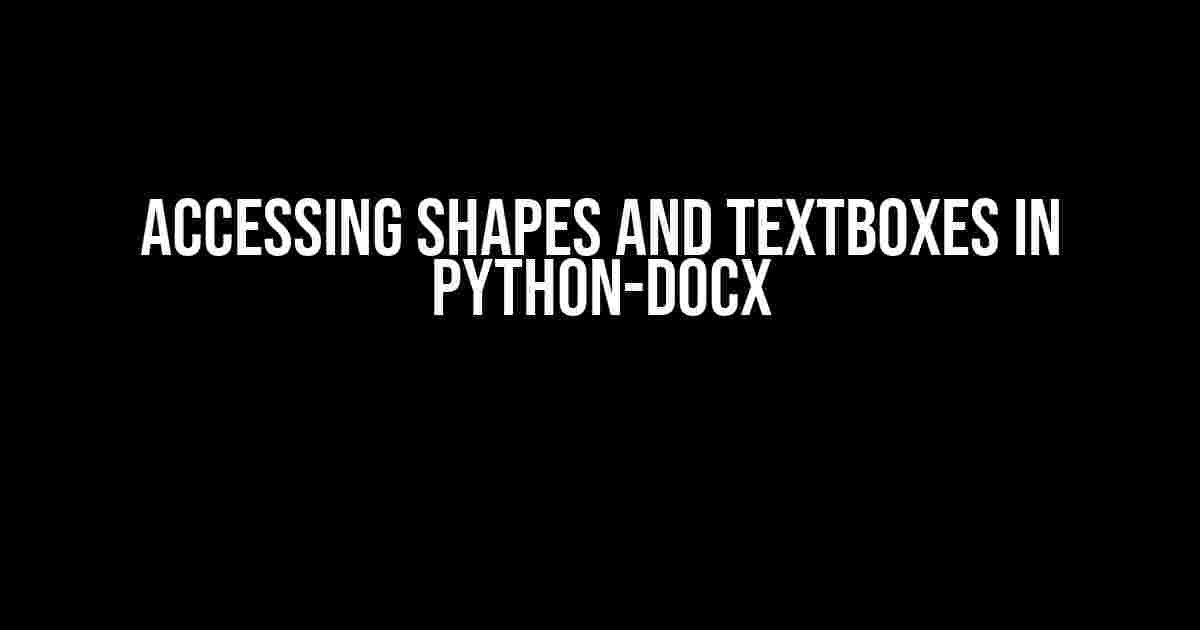Python-docx is a powerful library that allows you to create and modify Microsoft Word (.docx) files programmatically. One of the most exciting features of python-docx is the ability to work with shapes and textboxes in your Word documents. In this article, we’ll dive into the world of shapes and textboxes and explore how to access and manipulate them using python-docx.
Why Access Shapes and Textboxes?
Shapes and textboxes are essential elements in Microsoft Word documents. They can be used to add visual appeal, organize content, and convey information in a more engaging way. By accessing shapes and textboxes in python-docx, you can:
- Create dynamic documents that adapt to changing data
- Automate the creation of repetitive tasks, such as generating reports or invoices
- Enhance the visual appeal of your documents with custom shapes and textboxes
- Extract data from existing documents and manipulate it programmatically
Prerequisites
Before we dive into the world of shapes and textboxes, make sure you have:
- Python installed on your machine (version 3.6 or higher)
- The python-docx library installed using pip (
pip install python-docx) - A basic understanding of Python programming
Loading a Document
To access shapes and textboxes, we need to load a document using python-docx. Let’s create a simple script to load a sample document:
import docx
# Load the document
doc = docx.Document('sample.docx')
In this example, we’re loading a document named “sample.docx” into the doc variable.
Accessing Shapes
Shapes are graphical elements in a Word document, such as rectangles, ellipses, and polygons. To access shapes, we need to iterate through the document’s elements using the shapes property:
# Iterate through shapes
for shape in doc.inline_shapes:
print(shape.shape_type)
In this example, we’re iterating through the inline_shapes property, which returns a list of shape elements. The shape_type property returns the type of shape (e.g., “rect”, “ellipse”, etc.).
Accessing Textboxes
Textboxes are rectangular shapes that contain text. To access textboxes, we need to iterate through the document’s elements using the textbox property:
# Iterate through textboxes
for tb in doc.textboxes:
print(tb.text)
In this example, we’re iterating through the textboxes property, which returns a list of textbox elements. The text property returns the text content of the textbox.
Working with Shapes and Textboxes
Now that we’ve accessed shapes and textboxes, let’s explore some common operations you can perform on them:
Adding a Shape
To add a shape to a document, we can use the add_shape method:
# Add a rectangle shape shape = doc.add_shape(docx.enum.shape.SHAPE_TYPE.RECT, 100, 100, 200, 200)
In this example, we’re adding a rectangle shape with a width of 200 pixels and a height of 200 pixels, positioned 100 pixels from the top-left corner of the document.
Adding a Textbox
To add a textbox to a document, we can use the add_textbox method:
# Add a textbox tb = doc.add_textbox(100, 100, 200, 200, 'Hello, World!')
In this example, we’re adding a textbox with a width of 200 pixels and a height of 200 pixels, positioned 100 pixels from the top-left corner of the document, containing the text “Hello, World!”.
Modifying Shape and Textbox Properties
Once you’ve accessed or added shapes and textboxes, you can modify their properties using various methods:
# Modify shape properties shape.fill.solid() shape.line.color.rgb = docx.shared.RGBColor(0x0, 0x0, 0x0) # Modify textbox properties tb.text = 'New Text' tb.width = 300 tb.height = 300
In this example, we’re modifying the fill color, line color, and text content of a shape, and modifying the text content, width, and height of a textbox.
Extracting Data from Shapes and Textboxes
Sometimes, you may need to extract data from shapes and textboxes in a document. python-docx provides several methods to achieve this:
Extracting Text from Textboxes
To extract text from a textbox, we can use the text property:
# Extract text from a textbox tb_text = tb.text print(tb_text)
In this example, we’re extracting the text content of a textbox and printing it to the console.
Extracting Data from Shapes
To extract data from a shape, we can use the alt_text property:
# Extract alt text from a shape shape_alt_text = shape.alt_text print(shape_alt_text)
In this example, we’re extracting the alternative text associated with a shape and printing it to the console.
Conclusion
Accessing shapes and textboxes in python-docx is a powerful feature that unlocks a new level of document automation and customization. By following this guide, you should now be able to load documents, access shapes and textboxes, and perform various operations on them. With these skills, you can create dynamic documents, automate repetitive tasks, and extract data from existing documents.
| Method | Description |
|---|---|
doc.inline_shapes |
Returns a list of shape elements in the document |
doc.textboxes |
Returns a list of textbox elements in the document |
doc.add_shape() |
Adds a new shape to the document |
doc.add_textbox() |
Adds a new textbox to the document |
shape.fill.solid() |
Sets the fill color of a shape to solid |
tb.text |
Gets or sets the text content of a textbox |
Remember to explore the python-docx documentation for more advanced features and examples. Happy coding!
Frequently Asked Questions
Get ready to unleash the power of python-docx! Here are some frequently asked questions about accessing shapes and textboxes in python-docx.
How can I access a shape in a Word document using python-docx?
You can access a shape in a Word document using python-docx by iterating over the shapes in the document using the `document.shapes` property. For example: `for shape in document.shapes: print(shape.shape_type)`. This will print the type of each shape in the document.
How can I access a textbox within a shape in python-docx?
You can access a textbox within a shape in python-docx by accessing the `shape.text_frame` property, which returns a `TextFrame` object. From there, you can access the text in the textbox using the `text_frame.text` property. For example: `textbox_text = shape.text_frame.text`.
Can I add a new shape to a Word document using python-docx?
Yes, you can add a new shape to a Word document using python-docx by using the `document.add_picture()` or `document.add_shape()` methods. For example: `document.add_picture(‘image.png’)` or `document.add_shape(document.add_picture(‘image.png’), 100, 100)`. This will add a new picture or shape to the document at the specified coordinates.
How can I modify the text in a textbox using python-docx?
You can modify the text in a textbox using python-docx by accessing the `text_frame.paragraphs` property, which returns a list of `Paragraph` objects. From there, you can access the text in the textbox using the `paragraph.text` property and modify it as needed. For example: `textbox_text = shape.text_frame.paragraphs[0].text = ‘New text’`.
Can I delete a shape or textbox from a Word document using python-docx?
Unfortunately, python-docx does not currently support deleting shapes or textboxes from a Word document. However, you can use the `shape._element.getparent().remove(shape._element)` method to remove a shape from the document, but be careful when using this method as it can have unintended consequences.


